 Mark Howard, Regen’s lead on the internal Sustainability Task Force, outlines Regen’s net zero commitment, our journey to making it, and how others can join the Race To Zero.
Mark Howard, Regen’s lead on the internal Sustainability Task Force, outlines Regen’s net zero commitment, our journey to making it, and how others can join the Race To Zero.

Race To Zero – the start of a journey
Net zero by 2030
Emissions from the business sector contribute 18% of the UK’s greenhouse gas emissions[1].
Regen recently made a commitment to be net zero by 2030; in the next nine years we will reduce the greenhouse gas emissions associated with our business to as close to zero as possible, with any remaining emissions to be offset (a topic to discuss another day).
At the moment, we don’t know exactly how we’ll meet this target, but we have a pretty good idea of how to get some way to it, and the rest will unfold as part of the journey. We are keen to work collaboratively with our suppliers and networks, using our learning along the way to raise the overall ambition of the sector to reach net zero as soon as possible.
This blog talks about what we have learnt so far and the challenges of getting to the point where we can make this first step.
‘Green’ policies
As a mission-led organisation focussed on decarbonising the energy system, Regen has always strived to carry out our work with minimal environmental impact. We do the seemingly obvious things like buying recycled stationery, recycling our office waste, and buying our electricity from a green supplier.
Looking beyond our office, we support our staff to travel to work in the most low-carbon way possible by offering season ticket loans for rail travellers, allowing work hours to be flexible around public transport timetables, and supporting employees who want to cycle by providing dry cycle storage, showers and access to the ‘cycle to work’ scheme. We have also put a lot of thought into our (pre-Covid) events, sourcing food that is local and organic where possible, ensuring that we choose venues that are easy to access by public transport, and working with suppliers that understand these aims.
Is it enough?
In 2019 we asked ourselves ‘but are we doing enough?’ and realised that without a measure of our impact we would struggle to answer this question. So we decided to bring these threads of internal policy together and quantify our impacts, to understand what we are doing well, and what we need to work at.
Having led on sustainability auditing and policy development in a previous role, I was aware that this would need some resources and engagement with the Regen team. Bringing together a few interested colleagues, the ‘Sustainability Task Force’ was born.
After reviewing the various standards that we could follow, we assessed our estimated greenhouse gas emissions in line with the current HM Government ‘Environmental reporting guidelines’[2]. This methodology uses the internationally adopted approach of breaking emissions down into three separate scopes, that are defined by the depth of connection to the actual gases emitted, as highlighted in the graphic below.
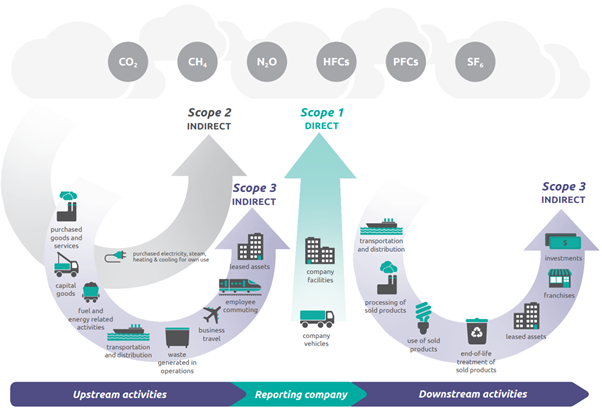
Scope 1 covers direct emissions of greenhouse gases – for Regen, this is limited to the emissions from our gas-fired heating system and some assumed leakage of refrigerant gases from the cooling unit that keeps our server room healthy.
Scope 2 covers the indirect emissions of greenhouse gases caused by electricity consumption. Although they do not occur on our site, they are clearly a result of our activities and so our responsibility.
Scope 3 is the broadest, capturing all other upstream and downstream emissions that arise from the products and services we use that are delivered by others. This covers everything from the laptops we buy to the sandwiches we serve at events (remember in-person events?) and everything in between.
Setting boundaries
It is common to monitor and report on scopes 1 and 2 as a minimum, with some flexibility over the inclusion of scope 3 emissions.
In recognition of the fact that our scope 1 and 2 emissions were likely to be relatively limited, and to get a full understanding of our impacts, we decided early on that we would include as broad a range of scope 3 as possible.
When we talk about our scope 3 emissions internally, we have taken to categorising them as ‘control’ and ‘influence’ emissions – those caused by the sandwiches we serve at events are ‘scope 3 – control’ as we choose the caterer; those caused by how our staff travel to work are ‘scope 3 – influence’ as we can influence these emissions through policies but we cannot control directly. We have found this useful in our discussions about how we can address scope 3 emissions in the future.
Adding it all up
Whilst we can be confident about the scale of our scope 1 and 2 emissions, that are based on reliable metered data, the downside of including scope 3 emissions is that the data quality is poorer and much of our assessment has been based on estimates. For those daunted by this task, it is worth knowing that guidelines recommend a ‘screening’ approach that can be taken for scope 3 emissions, estimating based on the cost of the services and the typical emissions for that sector.
The chart below shows our estimated emissions for 2019, categorised by scope.
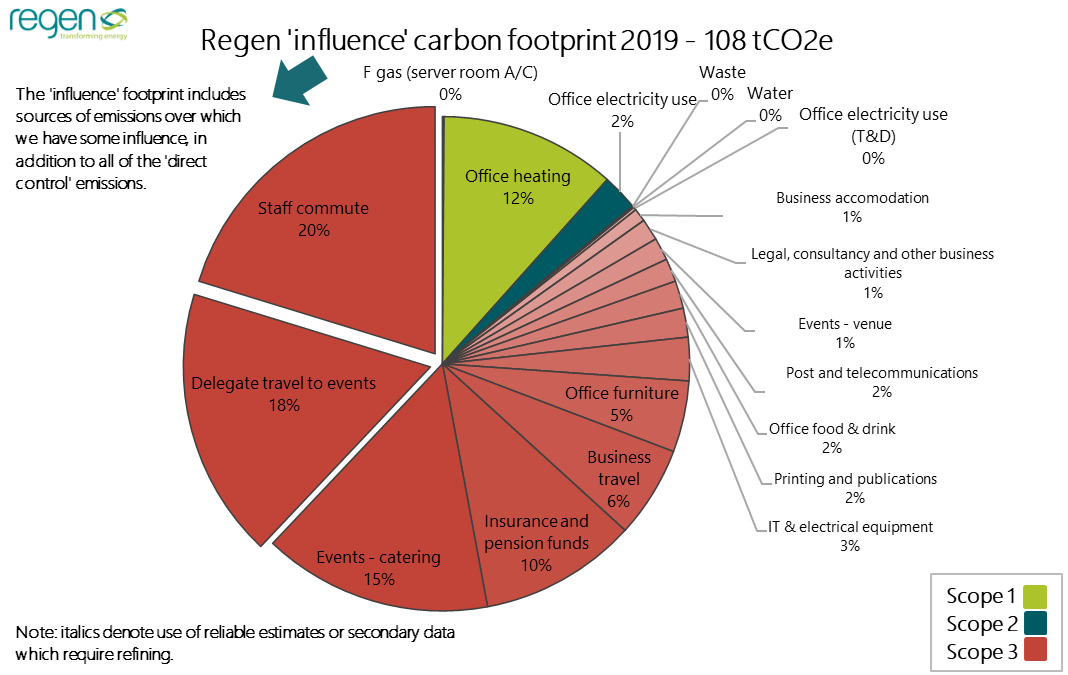
It is staggering to see the scale of emissions that we would be ignoring if we had simply adopted a boundary focussed on scope 1, scope 2 and scope 3 business travel, a boundary choice that is common in voluntary reporting.
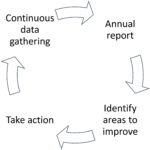
We intend to report this data annually, with new processes embedded in our practices to improve the quality of the data we have and to make annual reporting straight forward. The initial assessment we have completed has allowed us to identify the largest sources of our emissions, and where we should target our first efforts to make reductions. The annual reporting will allow us to assess the impact of any changes we make and inform ongoing work to further reduce our impact.
So, is it enough?
I could have answered that question in the first place – no, with a national net zero target we all need to think more carefully about what and how we do things, but now armed with this information we can celebrate what we do well and find out what we could do further.
We have found that our emissions are well below the industry benchmark for membership organisations, and we have also been surprised by the distribution of our emissions. Despite an expectation that our business travel (including a few flights) would be a large part of our footprint, the data shows that this accounts for only 11% of our emissions, with most mileage travelled by rail (the lowest carbon method, excluding EVs). Rail travel consequently makes up a comparatively small portion of business travel emissions. A strong existing policy of avoiding flying where possible shows through, with only 8% of business miles travelled by air.
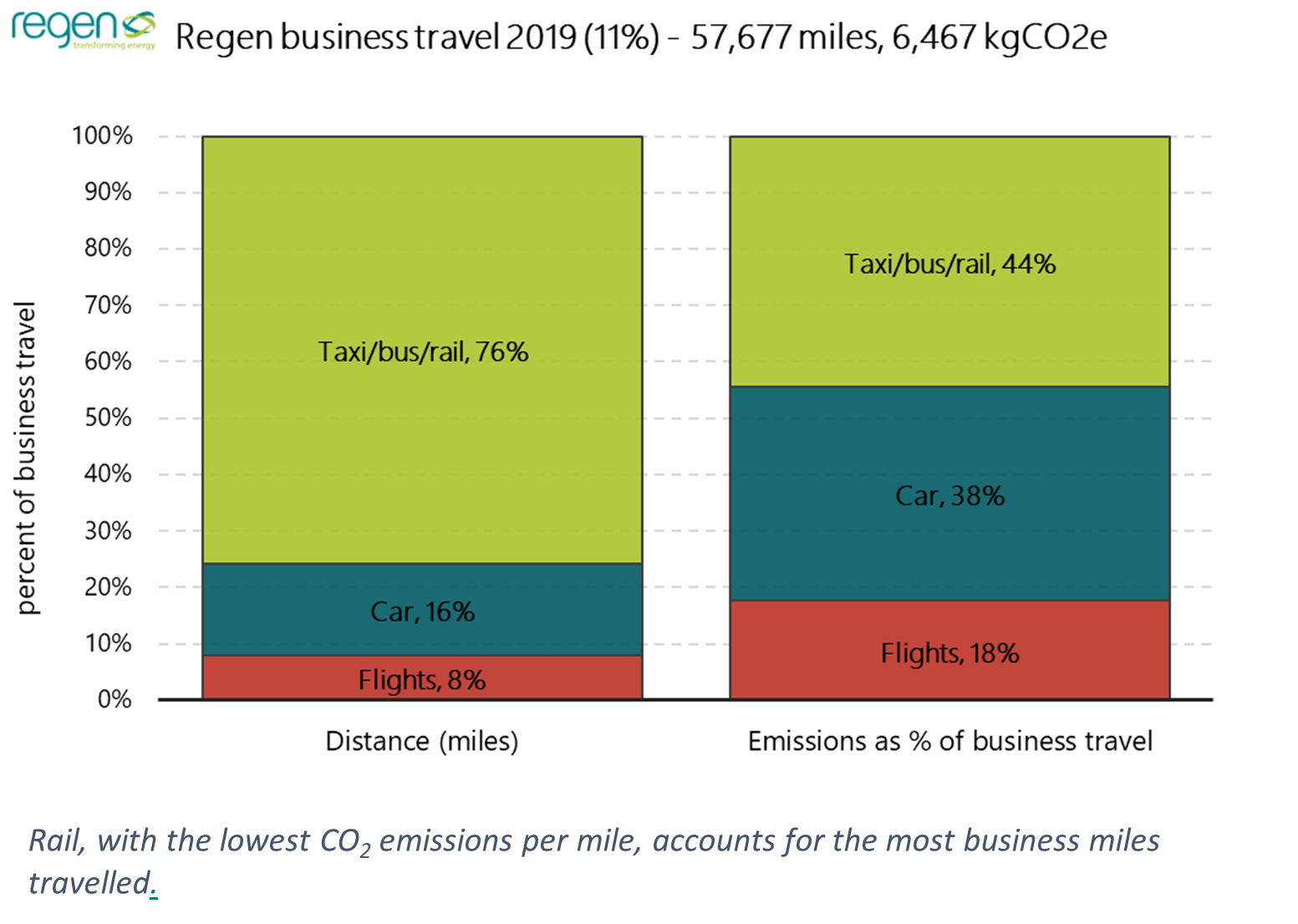
The location of our office was chosen to reduce barriers to sustainable commuting, and as a result in 2019 over 50% of staff commuted by train, bike or foot. Clearly in 2020 this will look quite different, raising questions over what the future of the office looks like. However there is a trade-off where reducing transport emissions could result in an increase in heat-related emissions, if staff are heating a home during work hours that would otherwise be left unheated.
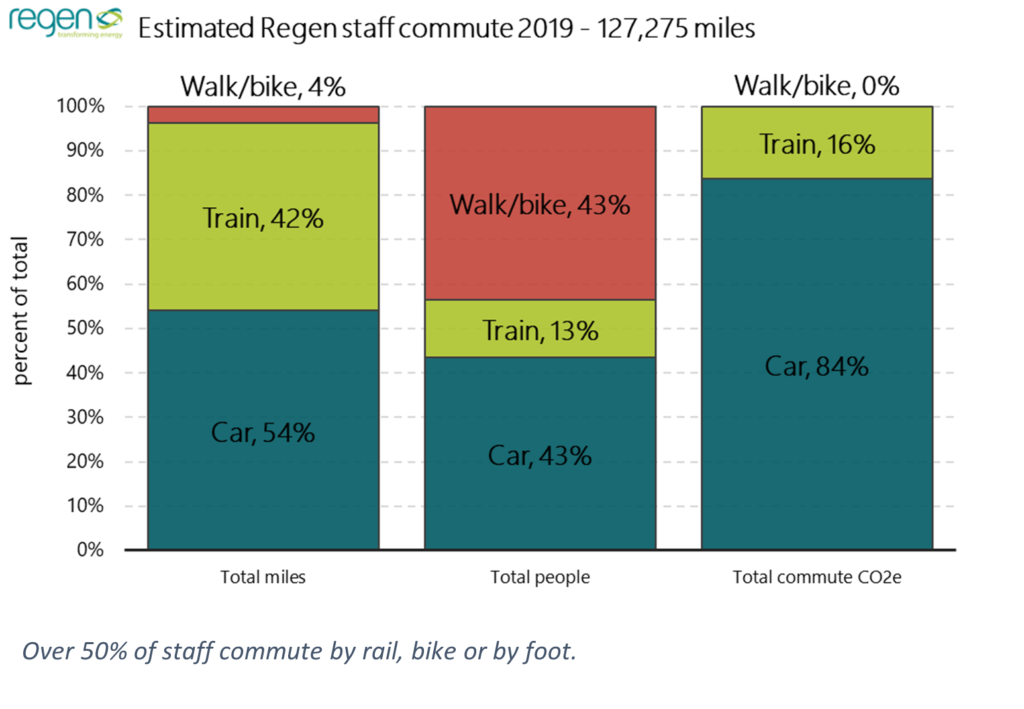
Setting a net zero target
We know that we all need to get to net zero; we now also know that for Regen this will be heavily dependent on bringing the people we work with along on the journey. We were fortunate enough to have had Nigel Topping, high-level climate champion for the UN, as a former board member. With encouragement from Nigel, who is leading the UNFCCC ‘Race To Zero’ campaign, we decided that setting a net zero target under the campaign, and embedding this in our policies, would bring the focus and drive needed to meet this ambitious goal.
This is the first in a series of blogs that will document our journey to net zero. In the next, I will discuss our first steps on how we will be making changes and working with suppliers to meet our net zero target.
About Race To Zero
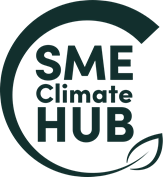
Regen has made a commitment to net zero under the UNFCCC ‘Race To Zero’ campaign. Race To Zero is a global campaign to rally leadership and support from businesses, cities, regions, investors for a healthy, resilient, zero carbon recovery that prevents future threats, creates decent jobs, and unlocks inclusive, sustainable growth. Individual actors (such as regions, cities, businesses and investors) are invited to join an initiative or network, which is an official Race To Zero partner. By joining one of the partners they will be directly included in Race To Zero.
Find out more about Race To Zero here, and SME Climate HUB here.
More information about our work addressing our environmental impacts can be found here. If you would like to discuss our work in this area further, please contact Mark.
—
[1] 2018 UK greenhouse gas emissions, provisional figures, BEIS, 2019
[2] Environmental reporting guidelines, DEFRA, 2019
What are the options for tackling emissions from office energy use? Does a green tariff materially affect our carbon footprint? Read the latest blog in our Race To Zero series, ‘The Race To Zero: electricity use and green tariffs’, here.
